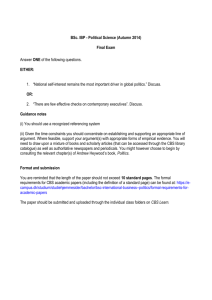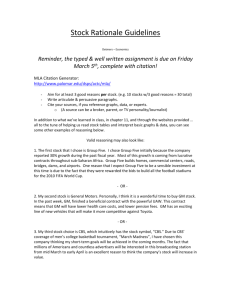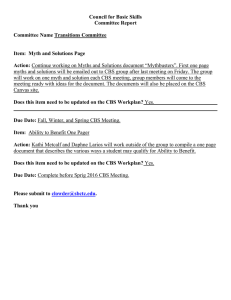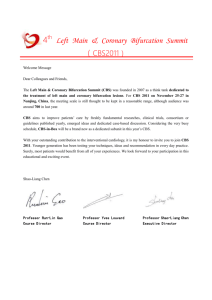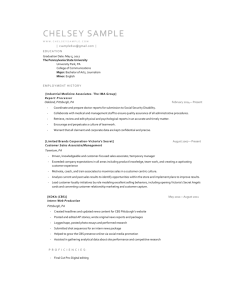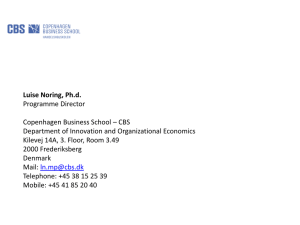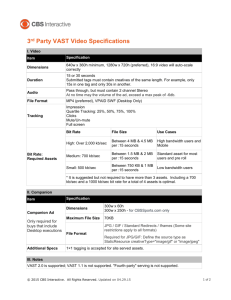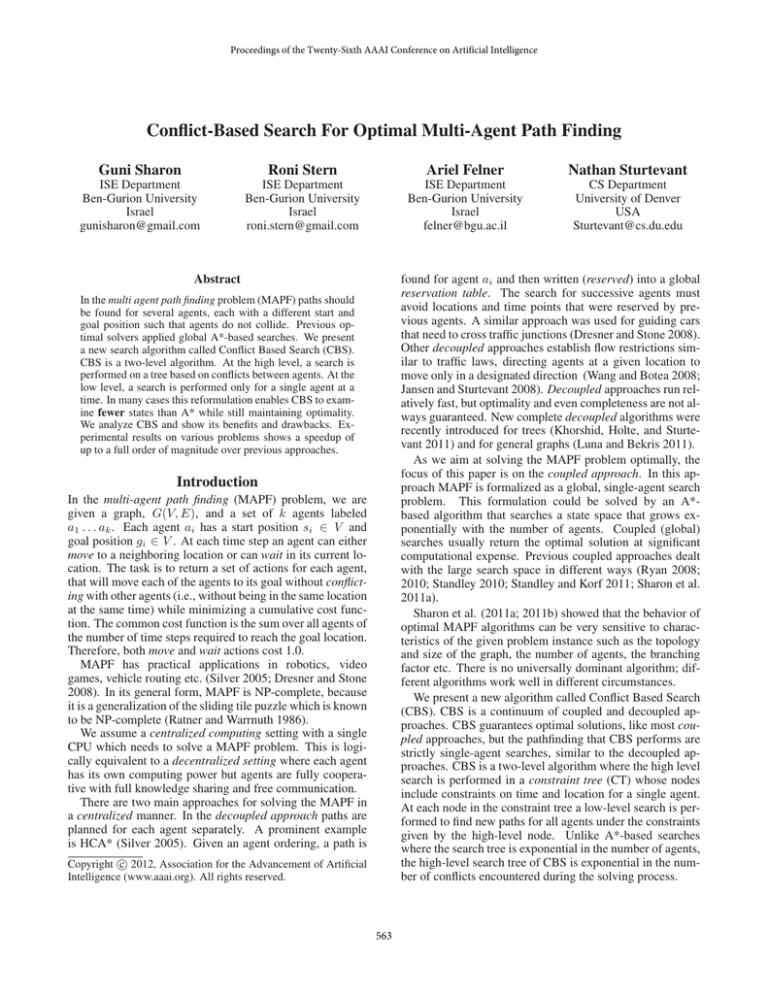
Proceedings of the Twenty-Sixth AAAI Conference on Artificial Intelligence
Conflict-Based Search For Optimal Multi-Agent Path Finding
Guni Sharon
Roni Stern
Ariel Felner
Nathan Sturtevant
ISE Department
Ben-Gurion University
Israel
gunisharon@gmail.com
ISE Department
Ben-Gurion University
Israel
roni.stern@gmail.com
ISE Department
Ben-Gurion University
Israel
felner@bgu.ac.il
CS Department
University of Denver
USA
Sturtevant@cs.du.edu
found for agent ai and then written (reserved) into a global
reservation table. The search for successive agents must
avoid locations and time points that were reserved by previous agents. A similar approach was used for guiding cars
that need to cross traffic junctions (Dresner and Stone 2008).
Other decoupled approaches establish flow restrictions similar to traffic laws, directing agents at a given location to
move only in a designated direction (Wang and Botea 2008;
Jansen and Sturtevant 2008). Decoupled approaches run relatively fast, but optimality and even completeness are not always guaranteed. New complete decoupled algorithms were
recently introduced for trees (Khorshid, Holte, and Sturtevant 2011) and for general graphs (Luna and Bekris 2011).
As we aim at solving the MAPF problem optimally, the
focus of this paper is on the coupled approach. In this approach MAPF is formalized as a global, single-agent search
problem. This formulation could be solved by an A*based algorithm that searches a state space that grows exponentially with the number of agents. Coupled (global)
searches usually return the optimal solution at significant
computational expense. Previous coupled approaches dealt
with the large search space in different ways (Ryan 2008;
2010; Standley 2010; Standley and Korf 2011; Sharon et al.
2011a).
Sharon et al. (2011a; 2011b) showed that the behavior of
optimal MAPF algorithms can be very sensitive to characteristics of the given problem instance such as the topology
and size of the graph, the number of agents, the branching
factor etc. There is no universally dominant algorithm; different algorithms work well in different circumstances.
We present a new algorithm called Conflict Based Search
(CBS). CBS is a continuum of coupled and decoupled approaches. CBS guarantees optimal solutions, like most coupled approaches, but the pathfinding that CBS performs are
strictly single-agent searches, similar to the decoupled approaches. CBS is a two-level algorithm where the high level
search is performed in a constraint tree (CT) whose nodes
include constraints on time and location for a single agent.
At each node in the constraint tree a low-level search is performed to find new paths for all agents under the constraints
given by the high-level node. Unlike A*-based searches
where the search tree is exponential in the number of agents,
the high-level search tree of CBS is exponential in the number of conflicts encountered during the solving process.
Abstract
In the multi agent path finding problem (MAPF) paths should
be found for several agents, each with a different start and
goal position such that agents do not collide. Previous optimal solvers applied global A*-based searches. We present
a new search algorithm called Conflict Based Search (CBS).
CBS is a two-level algorithm. At the high level, a search is
performed on a tree based on conflicts between agents. At the
low level, a search is performed only for a single agent at a
time. In many cases this reformulation enables CBS to examine fewer states than A* while still maintaining optimality.
We analyze CBS and show its benefits and drawbacks. Experimental results on various problems shows a speedup of
up to a full order of magnitude over previous approaches.
Introduction
In the multi-agent path finding (MAPF) problem, we are
given a graph, G(V, E), and a set of k agents labeled
a1 . . . ak . Each agent ai has a start position si ∈ V and
goal position gi ∈ V . At each time step an agent can either
move to a neighboring location or can wait in its current location. The task is to return a set of actions for each agent,
that will move each of the agents to its goal without conflicting with other agents (i.e., without being in the same location
at the same time) while minimizing a cumulative cost function. The common cost function is the sum over all agents of
the number of time steps required to reach the goal location.
Therefore, both move and wait actions cost 1.0.
MAPF has practical applications in robotics, video
games, vehicle routing etc. (Silver 2005; Dresner and Stone
2008). In its general form, MAPF is NP-complete, because
it is a generalization of the sliding tile puzzle which is known
to be NP-complete (Ratner and Warrnuth 1986).
We assume a centralized computing setting with a single
CPU which needs to solve a MAPF problem. This is logically equivalent to a decentralized setting where each agent
has its own computing power but agents are fully cooperative with full knowledge sharing and free communication.
There are two main approaches for solving the MAPF in
a centralized manner. In the decoupled approach paths are
planned for each agent separately. A prominent example
is HCA* (Silver 2005). Given an agent ordering, a path is
c 2012, Association for the Advancement of Artificial
Copyright Intelligence (www.aaai.org). All rights reserved.
563
Operator decomposition (OD): While the former two ideas
are general and can be used by any MAPF solver, OD is specific for an A*-based solver. OD reduces the branching factor by introducing intermediate states between the regular
states. Intermediate states are generated by applying an operator to a single agent only. This helps in pruning misleading directions at the intermediate stage without considering
moves of all of the agents (in a regular state).
We analyze CBS and study circumstances where CBS is
weak and when it is strong compared to the A*-based approaches. In many cases, CBS outperforms other optimal
solvers by up to a full order of magnitude.
Previous Optimal Solvers
The straightforward direction for optimal MAPF solvers is
to formalize the problem as a global search space and solve
it with A*. The states are the different ways to place the
k agents into the V vertices without conflicts. At the start
(goal) state agent ai is located at vertex si (gi ). Operators between states are all the non-conflicting actions (including wait) that all agents have. Let bbase be the branching factor for a single agent. The global branching factor
is b = O((bbase )k ). All (bbase )k combinations of actions
should be considered and only those with no conflicts are
legal neighbors. Any A*-based algorithm can then be used
to solve the problem.
A common heuristic function for MAPF solvers (Standley 2010; Sharon et al. 2011a) is the sum of individual costs
heuristic (SIC). For each agent ai we assume that no other
agents exist and calculate its optimal individual path cost.
We then return the sum of these costs. For grids with no obstacles this is exactly the Manhattan distance. The costs that
make up the SIC heuristics can be easily precalculated and
stored in k lookup tables, each of size |V |.
The Increasing Cost Tree Search (ICTS)
(Sharon et al. 2011a) introduced the increasing cost tree
search (ICTS). ICTS is based on the understanding that a
complete solution for the entire problem is built from individual paths (one for each agent). ICTS divides the MAPF
problem into two levels. At the high-level it searches a tree
called the increasing cost tree (ICT). Each node in this tree
is associated with a vector of costs, one per individual agent.
At the low-level it performs a goal test on the high-level ICT
nodes. Given the cost-per-agent vector it searches over combinations of single-agents paths, each with its cost from the
vector, to either find a non-conflicting solution with these
costs or to verify that such a solution does not exist.
(Sharon et al. 2011a) defined ∆ as the difference between
the optimal solution and the SIC heuristic of the initial state.
ICTS was shown to outperform the A* approaches in cases
where ∆ < k (the number of agents) and vise versa. (Sharon
et al. 2011b) suggested a number of pruning techniques that
allow the high-level to recognize that a given node is not
a goal without invoking the low-level. The best of these
techniques is called ICTS+3E. This enhancement uses information about small groups of up to 3 agents and their
internal conflicts. This is equivalent to an A* search with a
heuristic that is based on similar groups of up to 3 agents,
e.g., in the form of additive PDBs (Felner, Korf, and Hanan
2004). However, efficiently building such heuristics for general MAPF algorithms is an open question.
Standley’s enhancements
Recently, three methods that substantially improve the basic
A* setting were introduced by (Standley 2010). CBS uses
them so we describe each of them in turn.
Independence detection (ID): ID is a general framework
which runs as a base level and can use any possible MAPF
solver on top of it. Two groups of agents are independent
if there is an optimal solution for each group such that the
two solutions do not conflict. The basic idea of ID is to
divide the agents into independent groups. Initially each
agent is placed in its own group. Optimal solutions are found
for each group separately. Given a solution for each group,
paths are checked to see if a conflict occurs between two (or
more) groups. If so, all agents in the conflicting groups are
unified into a new group. Whenever a new group of k ≥ 1
agents is formed, this new k-agent problem is solved optimally by any MAPF optimal solver. This process is repeated until no conflicts between groups occur. Since the
problem is exponential in k, Standley observed that solving
the largest group dominates the running time of solving the
entire problem, as all others involve smaller groups.
Conflict voidance table (CAT): Within the ID framework,
a MAPF solver for a given group of agents is invoked. Since
many optimal solutions may exist for this group, Standley
suggested using a dynamic lookup table called the conflict
avoidance table (CAT). The CAT stores the location and
time of every agent in every group. Then, when an MAPF
solver is applied for a given group, ties between nodes with
the same f -value are broken in favor of the node that has
fewer entries in the CAT.
The Conflict Based Search Algorithm (CBS)
The state space of MAPF is exponential in k the number of
agents. By contrast, in a single-agent pathfinding problem,
(k = 1), and the state space is only linear in the graph size.
CBS solves the MAPF problem by decomposing it into a
large number of single-agent pathfinding problems. Each
problem is relatively simple to solve, but there may be an
exponential number of such single-agent problems.
Definitions for CBS We use the term path only in the context of a single agent and use the term solution to denote a
set of k paths for the given set of k agents. A constraint
for a given agent ai is a tuple (ai , v, t) where agent ai is
prohibited from occupying vertex v at time step t. During
the course of the algorithm agents are associated with constraints. A consistent path for agent ai is a path that satisfies
all its constraints. Likewise, a consistent solution is a solution that is made up from paths, such that the path for agent
ai is consistent with the constraints of ai . A conflict is a tuple (ai , aj , v, t) where agent ai and agent aj occupy vertex
v at time point t. A solution (of k paths) is valid if all its
paths have no conflicts. A consistent solution can be invalid
564
if, despite the fact that the paths are consistent with their
individual agent constraints, these paths still have conflicts.
The key idea of CBS is to grow a set of constraints for
each of the agents and find paths that are consistent with
these constraints. If these paths have conflicts, and are thus
invalid, the conflicts are resolved by adding new constraints.
CBS works in two levels. At the high level conflicts are
found and constraints are added. The low-level updates the
agents paths to be consistent with the new constraints. We
describe each part of this process in more detail below.
Algorithm 1: high-level of CBS
Input: MAPF instance
1 R.constraints = ∅
2 R.solution = find individual paths using the
low-level()
3 R.cost = SIC(R.solution)
4 insert R to O PEN
5 while O PEN not empty do
6
P ← best node from O PEN // lowest solution cost
7
Validate the paths in P until a conflict occurs.
8
if P has no conflict then
9
return P.solution // P is goal
10
C ← first conflict (ai , aj , v, t) in P
11
foreach agent ai in C do
12
A ← new node
13
A.constriants ← P.constriants + (ai , s, t)
14
A.solution ← P.solution.
15
Update A.solution by invoking low-level(ai )
16
A.cost = SIC(A.solution)
17
Insert A to O PEN
High-level: Search the Constraint Tree (CT)
At the high-level, CBS searches a constraint tree (CT). A
CT is a binary tree. Each node N in the CT contains
the following fields of data:
(1) A set of constraints
(N.constraints). The root of the CT contains an empty
set of constraints. The child of a node in the CT inherits the
constraints of the parent and adds one new constraint for one
agent. (2) A solution (N.solution). A set of k paths, one
path for each agent. The path for agent ai must be consistent
with the constraints of ai . Such paths are found by the lowlevel
(3) The total cost (N.cost) of the current solution
(summation over all the single-agent path costs). We denote
this cost the f -value of the node.
Node N in the CT is a goal node when N.solution is
valid, i.e., the set of paths for all agents have no conflicts.
The high-level performs a best-first search on the CT where
nodes are ordered by their costs. Ties are broken by using a
conflict avoidance table (CAT) as described above.
the exception of the root node, the low-level search should
only be performed for agent ai which is associated with the
newly added constraint. The paths of other agents remain
the same as no new constraint was added for them.
CBS Example
Processing a node in the CT Given the list of constraints
for a node N of the CT, the low-level search is invoked. This
search returns one shortest path for each agent, ai , that is
consistent with all the constraints associated with ai in node
N . Once a consistent path has been found for each agent
with respect to its constraints, these paths are then validated
with respect to the other agents. The validation is performed
by simulating the set of k paths. If all agents reach their goal
without any conflict, this CT node N is declared as the goal
node, and the current solution (N.solution) that contains
this set of paths is returned. If, however, while performing
the validation a conflict C = (ai , aj , v, t) is found for two
or more agents ai and aj , the validation halts and the node
is declared as a non-goal node.
The high-level of CBS is shown in Algorithm 1. It has the
structure of a best-first search. We cover it using the example in Figure 1(i), where the mice need to get to their
respective pieces of cheese. The corresponding CT is shown
in Figure 1(ii). The root contains an empty set of constraints.
The low-level now returns an optimal solution for each agent
(line 2 of Algorithm 1) , < S1 , A1 , C, G1 > for a1 and
< S2 , B1 , C, G2 > for a2 . Thus, the total cost of this node
is 6. All this information is kept inside this node. The root is
then inserted into the O PEN list and will be expanded next.
When validating the two-agent solution given by the two
individual paths (line 7) a conflict is found when both agents
arrive to vertex C at time step 2. This creates the conflict
(a1 , a2 , C, 2). As a result, the root is declared as non-goal
and two children are generated in order to resolve the conflict (Line 11). The left child, adds the constraint (a1 , C, 2)
while the right child adds the constraint (a2 , C, 2). The lowlevel search is now invoked (Line 15) to find an optimal path
that also satisfies the new constraint. For the left child, a1
must wait one time step either at S1 (or at A1 ) and the path
< S1 , A1 , A1 , C, G1 > is returned for a1 . The path for a2 ,
< S2 , B1 , C, G2 > remains unchanged for the left child.
The total cost for the left child is now 7. In a similar way,
the right child is generated, also with cost 7. Both children
are added to O PEN (Line 17). In the final step the left child
is chosen for expansion, and the underlying paths are validated. Since no conflicts exist, the left child is declared as a
goal node (Line 9) and its solution is returned as an optimal
solution.
Resolving a conflict Given a non-goal CT node N whose
solution N.solution includes a conflict Cn = (ai , aj , v, t)
we know that in any valid solution at most one of the
conflicting agents (ai and aj ) may occupy vertex v at
time t. Therefore, at least one of the constraints (ai , v, t)
or (aj , v, t) must be added to the set of constraints in
N.constraints. To guarantee optimality, both possibilities
are examined and N , is split into two children. Both children
inherit the set of constraints from N . The left child resolves
the conflict by adding the constraint (ai , v, t) and the right
child adds the constraint (aj , v, t).
Note that for a given CT node N one does not have to save
all its cumulative constraints. Instead, it can save only its latest constraint and extract the other constraints by traversing
the path from N to the root via its ancestors. Similarly, with
565
Figure 1: (i) MAPF example (ii) CT (iii) A k-way (top) and binary (bottom) CT (iv) A case where A* outperforms CBS.
Definition 1 For given node N in a constraint tree, let
CV (N ) be the set of all solutions that are: (1) consistent
with the set of constraints of N and (2) are also valid (i.e,
without conflicts).
Conflicts of k > 2 agents.
It may be the case that
while performing the validation (Line 7) between the different paths a k-agent conflict is found for k > 2. There are
two ways to handle such k-agent conflicts. We can generate
k children, each of which adds a constraint to k − 1 agents
(i.e., each child allows only one agent to occupy the conflicting vertex v at time t). Or, an equivalent formalization
is to only focus on the first two agents that are found to conflict, and only branch according to their conflict. This leaves
further conflicts for deeper levels of the tree.
This is illustrated in Figure 1(iii). The top tree represent
a k-way branching CT for a problem that contains a 3-agent
conflict at vertex v at time t. The bottom tree presents a
binary CT for the same problem. As can be seen the size of
the deepest layer in both trees is similar. The complexity of
the two approaches is the same as they both will end up with
k nodes each with k − 1 new constraints. For simplicity of
description we chose the second option.
If N is not a goal node, then the solution at N will not be
part of CV (N ) because it is not valid.
Definition 2 For any solution p ∈ CV (N ) we say that
node N permits the solution p.
The root of the CT, for example, has an empty set of constraints. Any valid solution satisfies the empty set of constraints. Thus the root node permits all valid solutions.
The cost of a solution in CV (N ) is the sum of the costs of
the individual agents. Let minCost(CV (N )) be the minimum cost over all solutions in CV (N ).
Lemma 1 The cost of a node N in the CT is a lower bound
on minCost(CV (N )).
Proof: N.cost is the optimal cost of a set of paths that
satisfy the constraints of N . This set of paths is not necessarily a valid solution. Thus, N.cost is a lower bound on the
cost of any set of paths that make a valid solution for N as
no single agent in any solution can achieve its goal faster. 2
Low-level: Find Paths for CT Nodes
The low-level is given an agent, ai , and a set of associated constraints. It performs a search in the underlying
graph to find an optimal path for agent ai that satisfy all
its constraints. Agent ai is solved in a decoupled manner,
i.e., while ignoring the other agents. This search is threedimensional, as it includes two spatial dimensions, and one
dimension of time. Any single agent path-finding algorithm
can be used to find the path for agent ai , while verifying
that the constraints are satisfied. We used A* with a perfect
heuristic in the two spatial dimensions. Whenever a state
x is generated with g(x) = t and there exists a constraint
(ai , x, t) in the current CT node this state is discarded.
A low-level CAT was used for each CT node N . It is initialized by the current paths of node N . When two low-level
states have the same f -values the state with the smallest
number of conflicts in the low-level CAT is preferred. This
results in a higher quality solution (less conflicting agents)
for each high-level node.
Lemma 2 Let p be a valid solution. At all time steps there
exists a CT node N in O PEN that permits p.
Proof: By induction on the expansion cycle: For the base
case O PEN only contains the root node, which has no constraints. Consequently, the root node permits all valid solutions and also p. Now, assume this is true for the first i
expansion cycles. In cycle i + 1, assume that node N , which
permits p, is expanded and its children N10 , N20 are generated.
Any valid solution in V S(N ) must be either in V S(N10 ) or
in V S(N20 ), as any valid solution must satisfy at least one of
the new constraints. 2
Thus, at all times at least one CT node in O PEN permits
the optimal solution (as a special case of Lemma 2).
Theorem 1 CBS returns the optimal solution.
Proof: Consider the expansion cycle when a goal node G
is chosen for expansion by the high-level. At that point
all valid solutions are permitted by at least one node from
O PEN (lemma 2). Let p be a valid solution (with cost c(p))
and let N (p) be the node that permits p in O PEN, Let c(N )
Theoretical Analysis: Optimality of CBS
We now prove that CBS will returns an optimal solution if
one exists. First, we provide several supporting claims.
566
k
3
4
5
6
7
8
9
10
11
12
13
A*
414
2,843
19,061
64,734
NA
NA
NA
NA
NA
NA
NA
#Generated nodes
A*+OD CBS(hl)
82
7
243
31
556
42
677
42
4,451
287
8,035
308
30,707
740
54,502
1,095
NA
2,150
NA
11,694
NA
22,995
CBS(ll)
229
1,135
1,142
1,465
13,804
13,820
25,722
34,191
69,363
395,777
838,149
A*
14
380
9,522
47,783
NA
NA
NA
NA
NA
NA
NA
Run-Time (ms)
A*+OD
ICTS ICTS3
3
1
1
10
2
1
50
5
5
90
9
10
1,122
92
44
1,756
271
128
7,058
2,926
921
21,334 10,943
2,335
NA 38,776
5,243
NA
NA 25,537
NA
NA 45,994
CBS
2
13
13
16
186
211
550
1,049
2,403
15,272
36,210
Figure 2: Nodes generated and running time on 8x8 grid (left). Success rate (right)
∗
2|V |×C × |V | × C ∗ . Again, in practice Y and Y can be
significantly smaller.
A* searches a single search tree and expands X nodes.
CBS performs a high-level search in the CT and then a lowlevel search in the underlying graph and expands a total of
Y low-level states. Thus, if Y << X then CBS will outperform A* and vise versa. We now show special cases where
Y << X (bottleneck) and where X << Y (open space).
This seems to be typical for MAPF, where the topology of
the domain greatly influences the behavior of algorithms.
The main difference between the behavior of the algorithms
in the different cases is the amount of work that needs to be
done before the f -cost of the searches increases. The examples below demonstrate this for simple cases but they can be
easily generalized.
be the cost of node N . c(N (p)) ≤ c(p) (Lemma 1). Since
G is a goal node c(G) is a cost of a valid solution. Since
the high-level search explores solution costs in a best-first
manner we get that c(g) ≤ c(N (p)) ≤ c(p) 2
Comparison with other algorithms
∗
Let C be the cost of the optimal solution, let χ be the set of
nodes with f < C ∗ and let X = |χ|. It is well known that
A* must expand all nodes in χ in order to guarantee optimality. Furthermore, A* is known to be “optimally effective”,
which means that A* expands the minimal number of nodes
necessary to ensure an optimal solution (Dechter and Pearl
1985), for a given h function.
(Sharon et al. 2011a) showed that A* may generate up
to X × (bbase )k nodes while ICTS might generate up to
X × k ∆ nodes. As ICTS also expand all nodes in χ, we
currently limit the discussion to A*. But, what is the size of
set χ? Given a heuristic h and the solution depth d some
prediction algorithms were developed for IDA* but they
are based on sampling (Korf, Reid, and Edelkamp 2001;
Zahavi et al. 2010; Lelis, Zilles, and Holte 2011). The simplest upper bound for X is the entire state space, although
this can bea gross overestimate of X. In the case of MAPF
this is |Vk | = O(|V |k ).
Similar reasoning apply for CBS. Let Υ be the set of
nodes with f < C ∗ in the CT tree and let Y = |Υ|. As
a best-first search guided by f , CBS must expand all the
nodes in Υ. Again, prediction formulas might be developed
but we suffice by giving an upper bound. As the branching
factor of the CT is 2, 2d nodes must be expanded in the worst
case where d is depth of the solution.
At each node of the CT exactly one constraint is added.
In the worst case an agent will be constrained to avoid every
vertex except one at every time step in the solution. The total
number of time steps summed over all agents is C ∗ . Thus,
an upper bound on the number of CT nodes that CBS must
∗
expand is 2|V |×C . For each of these nodes the low-level
is invoked and expands at most |V | (single-agent) states for
each time step. The total number of time steps summed over
all agents is C ∗ . Let Y be the number of states expanded
in the underlying graph (low-level nodes) .Y is bounded by
A case where CBS outperforms A* (bottlenecks) Figure 1(i) demonstrates a case where Y << X, i.e., a case
where CBS expands fewer nodes than A*. As detailed
above, CBS generates three CT nodes. At the root, the lowlevel is invoked for the two agents. The low-level search
finds an optimal path for each of the two agents (each of
length 3), and expands a total of 8 low-level nodes for the
CT root. Now, a conflict is found at C. Two new CT
children nodes are generated. In the left child the lowlevel searches for an alternative path for agent a1 that does
not pass through C at time step 2. S1 plus all m states
A1 , . . . , Am are expanded with f = 3. Then, C and G1
are expanded with f = 4 and the search halts and returns
the path < S1 , A1 , A1 , C, G1 >. Thus, at the left child a total of m + 3 nodes were expanded. Similar m + 3 states are
expanded for the right child. Adding all these to the 8 states
expanded at the root we get that a total of Y = 2m + 14
low-level nodes were expanded.
Now, consider A* which is running in a 2-agent state
space. The root (S1 , S2 ) has f = 6. It generates m2 nodes,
all in the form of (Ai , Bj ) for (1 ≤ i, j ≤ m). All these
nodes are expanded with f = 6. Now, node (A1 , C) with
f = 7 is expanded (agent a1 waits at A1 ), Then nodes
(C, G2 ) and (G1 , G2 ) are expanded and the solution is returned. So, in total A* expanded X = m2 + 3 nodes.
For m ≥ 5 this is larger than 2m + 14 and consequently,
CBS will expand fewer nodes. A* must expand the carte-
567
k
5
10
15
20
25
den520d
A*
CBS
2,210
1,160
4,992
3,092
5,599
4,204
8,630
7,247
10,266 14,373
ost003d
A*
CBS
1,057
1,026
6,360
4,372
14,822
9,841
20,431 13,196
NA
NA
brc202d
A*
CBS
7,674
7,065
22,149 19,447
41,789 35,630
61,587 56,638
NA
NA
Table 1: Nodes expanded on DAO problems.
sian product of single agent paths with f = 3. By contrast,
CBS only tried two such paths to realize that no solution
of cost 6 is valid. Furthermore, the nodes counted for A*
are multi-agent nodes while for CBS, they are single-agent
states. This is another advantage of CBS – smaller constant
time per node.
A case where A* outperforms CBS (open space) Figure 1(iv) presents a case where Y >> X and A* will
outperform CBS. For this problem the initial SIC heuristic is 8. There are 4 optimal paths for each agent
but each of the 16 paths combinations has a conflict in
one of the gray cells. Consequently, C ∗ = 9 as one
agent must wait at least one step to avoid collision. For
this problem A* will expand 5 nodes with f = 8:
{(D2, C1), (D3, C2), (D3, B1), (C2, B1), (C3, B2)} and
3 nodes with f = 9 {(B3, B2), (A3, B3), (A3, B4)} until
the goal is found and a total of 8 nodes are expanded. Now,
consider CBS. Each agent has 4 different optimal paths. All
16 combinations have conflicts in one of the 4 gray cells
{C2, C3, B2, B3}. Therefore, for f = 8 a total of 16 CT
nodes will be expanded, each will expand 4 single-agent
states to a total of 16 × 4 = 64 low-level nodes. Next, we
consider the goal CT node with f = 9. It will expand 7 new
states. Thus, a total of Y = 71 states are expanded for CBS.
While it is hard to predict the performance of these algorithms in actual domains, the above observations can give
some guidance. If there are more bottlenecks, CBS will have
advantage over the A*-based approaches. If there are more
open spaces, A* will have advantage over CBS. Next we
show experimental results supporting both cases.
Figure 3: DAO maps den520d (top), ost003d (middle),
brc202d (bottom) and their success rate
Figure 2(left) presents the number of nodes generated and
the run time averaged over 100 instances. For the case of
CBS both the high-level nodes and low-level states are reported. We set a time limit of 5 minutes. If an algorithm
could not solve an instance within the time limit it was halted
and fail was returned (“NA” in the table). Figure 2(right)
shows the success rate, i.e., the percentage of instances that
could be solved under 5 minutes by the different algorithms
when the number of agents increase. Similar to (Sharon et
al. 2011a) we do not report the number of nodes for the ICTS
variants. This is because this algorithm is not based solely
on search. Clearly, CBS significantly outperforms A* and
A*+OD by up to a full order of magnitude. Note that although CBS sometimes generates more nodes than A*+OD,
it is still faster in many cases due to the fact that the constant
time per node of CBS (single-agent state) is smaller than that
of A*+OD (multiple agents). CBS is faster than ICTS and
ICTS+3E for ≥ 8 and ≥ 9 agents respectively.
Experimental results
We experimented with A*, A* enhanced by OD (denoted
A*+OD), ICTS, ICTS+3E and CBS. All algorithms, except ICTS+3E are based on the SIC heuristic. ICTS+3E
uses more advanced pruning that could potentially apply to
CBS and A* as advanced heuristics in the future. Despite
this, CBS without this advanced heuristic still outperforms
ICTS+3E in many scenarios. In all our experiments we also
tried CBS without the CAT-based tie braking. It was two
times slower than CBS with the CAT-based tie breaking.
Only the stronger version is shown.
DAO maps We also experimented on 3 benchmark maps
from the game Dragon Age: Origins (Sturtevant 2012).
Here we aimed to solve problems with as many agents and
thus the ID framework was activated as an integral part of the
problem solving. In this experiment we show results only for
the three strongest algorithms: A*+OD, ICTS+3E and CBS.
Table 1 shows the number of states expanded by CBS and
by A* for the three DAO maps presented in Figure 3 (left).
Clearly, CBS expands less states than A* in all these cases.
Additionally, recall that the cost of a CBS node expansion is
less than A*. The one exception is the den520d map for 25
agents.
8x8 4-connected grid We begin with an 8x8 4-connected
grid where the number of agents increases from 3 to 13. We
followed (Sharon et al. 2011a) and used the ID framework
only in a preprocessing level. We report results for agents
which were all in the same independent group found by ID.
568
Khorshid, M. M.; Holte, R. C.; and Sturtevant, N. R. 2011.
A polynomial-time algorithm for non-optimal multi-agent
pathfinding. In SOCS.
Korf, R. E.; Reid, M.; and Edelkamp, S. 2001. Time
complexity of iterative-deepening-A*. Artificial Intelligence
129(1–2):199–218.
Lelis, L.; Zilles, S.; and Holte, R. C. 2011. Improved prediction of IDA*s performance via -truncation. In SoCS.
Luna, R., and Bekris, K. E. 2011. Push and swap: Fast
cooperative path-finding with completeness guarantees. In
IJCAI, 294–300.
Ratner, D., and Warrnuth, M. 1986. Finding a shortest solution for the N × N extension of the 15-puzzle is intractable.
In AAAI-86, 168–172.
Rintanen, J. 2011. Planning with sat, admissible heuristics
and a*. In IJCAI, 2015–2020.
Ryan, M. 2008. Exploiting subgraph structure in multi-robot
path planning. JAIR 31:497–542.
Ryan, M. 2010. Constraint-based multi-robot path planning.
In ICRA, 922–928.
Sharon, G.; Stern, R.; Goldenberg, M.; and Felner, A.
2011a. The increasing cost tree search for optimal multiagent pathfinding. In IJCAI, 662–667.
Sharon, G.; Stern, R.; Goldenberg, M.; and Felner, A.
2011b. Pruning techniques for the increasing cost tree search
for optimal multi-agent pathfinding. In SOCS.
Silver, D. 2005. Cooperative pathfinding. In AIIDE, 117–
122.
Standley, T., and Korf, R. 2011. Complete algorithms for
cooperative pathnding problems. In IJCAI, 668–673.
Standley, T. 2010. Finding optimal solutions to cooperative
pathfinding problems. In AAAI, 173–178.
Sturtevant, N. 2012. Benchmarks for grid-based pathfinding. Transactions on Computational Intelligence and AI in
Games.
Wang, K. C., and Botea, A. 2008. Fast and memory-efficient
multi-agent pathfinding. In ICAPS, 380–387.
Zahavi, U.; Felner, A.; Burch, N.; and Holte, R. C. 2010.
Predicting the performance of IDA* (with BPMX) with conditional distributions. Journal of Artificial Intelligence Research 37:41–83.
Figure 3(right) shows the success rates given the number
of agents for the three maps Here the results are mixed and
there is no global winner. One can clearly see that ICTS+3E
is always better than A*+OD. However, the performance of
CBS on these maps supports our theoretical claims that CBS
is very effective when dealing with corridors and bottlenecks
but rather inefficient in open spaces. For den520d(top) there
are no bottlenecks but there are large open spaces; CBS
was third. For ost003d(middle) there are few bottlenecks
and small open spaces; CBS was intermediate. Finally, for
brc202b(bottom) there are many narrow corridors and bottlenecks but very few open spaces, thus CBS was best. Note
that while both den520 and ost003 have open spaces they
differ in the amount of bottlenecks.
Discussion and future work
This paper introduces the CBS algorithm for solving MAPF
problems optimally. CBS is unique in that all low-level
searches are performed as single-agent searches. The performance of CBS depends on the structure of the problem.
We have demonstrated cases with bottlenecks (Figure 1(i))
where CBS performs well, and open spaces (Figure 1(iv))
where CBS performs poorly. Experimental results in testbed
map problems support our theoretical claims. These domains have different rates of open spaces and bottlenecks.
CBS outperforms other algorithms in cases where corridors
and boutlnecks are more dominant.
Recently a number of optimal MAPF solvers have been
introduced, each with pros and cons, but there is no universal winner. We have touched the surface here; further
research is needed on the characteristics of MAPF and how
they influence the behavior of different algorithms.
A number of ongoing directions for CBS include: (1)
Adapting the meta-agent ideas from ICTS+3E. (2) Performing independence detection for CT nodes. (3) Finding admissible heuristics for the CT. (4) The approach of mixing
constraints and search is related to recent work on the theoretical properties of A* and SAT algorithms (Rintanen 2011)
and is an important connection that needs more study. (5)
The relation to CSP solvers is still not deeply known.
Acknowledgements
This research was supported by the Israeli Sience Foundation (ISF) under grant #305/09 to Ariel Felner.
References
Dechter, R., and Pearl, J. 1985. Generalized best-first search
strategies and the optimality of A*. Journal of the ACM
32(3):505–536.
Dresner, K., and Stone, P. 2008. A multiagent approach to
autonomous intersection management. JAIR 31:591–656.
Felner, A.; Korf, R. E.; and Hanan, S. 2004. Additive pattern database heuristics. Journal of Artificial Intelligence
Research 22:279–318.
Jansen, M., and Sturtevant, N. 2008. Direction maps for
cooperative pathfinding. In AIIDE.
569

